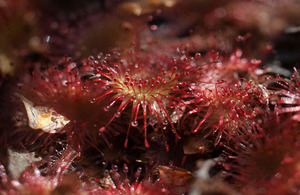‘The nature of flight’ takes off at Yorkshire Air Museum
New film reveals fascinating story of Skipwith Common National Nature Reserve

Round-leaved sundew at Skipwith Common NNR © Steve Hiner/Natural England
A new film has been produced by Natural England and the Yorkshire Air Museum that reveals the fascinating history of the Royal Air Force station at Skipwith Common in North Yorkshire.
Commissioned in 1942 as RAF Riccall and used as an airfield and training centre during World War 2, Natural England is now working with the landowners to manage Skipwith Common as England’s newest National Nature Reserve (NNR).
The nature of flight film uses original archive footage and interviews, interspersed with beautiful new images of Skipwith Common, to reveal how nature is reclaiming the site and transforming it from a place of warfare into a peaceful haven for visitors.
The film was made by Natural England’s NNR team, Phil Robinson and Craig Ralston, and was produced with the full support of the Eskrick Park Estate, who own Skipwith Common.
Skipwith Common NNR is already an important home for rare species, such as the nocturnal flying nightjar and the insect-eating sundew plant. The old brick bomb bays are now a haven for grass snakes and other reptiles, while the air raid shelters and runways are gradually disappearing beneath a cloak of vegetation.
David Shaw, Natural England’s area manager for Yorkshire and Northern Lincolnshire, said:
Partnership working is at the heart of work at Skipwith Common and I’m delighted we’ve been able to work with the Yorkshire Air Museum and Allied Air Forces Memorial on this stunning film. Skipwith Common National Nature Reserve is now a peaceful place which is steeped in history.
It is an important home for wildlife, shaped by generations of human activity and a living memorial to those who fought to protect our freedom and paid the ultimate price. The launch of this film reminds us of Skipwith Common’s past, present and future and is an excellent way of demonstrating what we can achieve for this wonderful site by closely working together.
The film was premièred at the Yorkshire Air Museum on 25 May 2015 where it will be shown in a permanent display as a part of the museum’s nature of flight project.
You can watch the 11 minute long film here and find more Natural England films on our YouTube channel
Ian Reed, Museum Director said:
As a history of aviation museum, our own “nature of flight” environmental area has enabled us to explain the story of the birth of flight from the earliest aviators and their study of flying insects and birds. As a national aviation memorial, the close partnership we have with Natural England and their success with the former wartime base at Riccall has enabled us to complete another chapter in the story of the extraordinary courage and sacrifice of wartime airmen 70 years ago.
Situated in a 22 acre parkland site on the former World War 2 RAF Bomber Command Station at Elvington near the City of York, the Yorkshire Air Museum and Allied Air Forces Memorial is the largest independent air museum in Britain. Natural England and the Yorkshire Air Museum have been working together for over a decade on landscape scale environmental projects encompassing the museum and the Lower Derwent Valley and Skipwith Common NNRs.
Background
Skipwith Common NNR is one of the last remaining areas of northern lowland heath in England. An incredible variety of plants and animals depend on the common for their survival. The 270ha of open heath, ponds and mire is an ancient landscape, with its roots in pre-history.
Skipwith Common’s heathland has stayed almost the same for thousands of years – with evidence of its use by man for at least 4000 years. For thousands of years the heathland was kept open by people grazing their animals, taking birch, gorse, and cutting turf and peat for fuel. This digging peat has created the many ponds on the site. The common is dotted with Bronze and Iron Age features as well as much evidence of its more recent use during World War 2. During the war a bomber training airfield was constructed on the western end of the Common and much of the infrastructure, one of the runways, and other features survive both on and adjacent to the common on both north and south sides. These features mean there are good paths to use all year round.
Today, the site is a National Nature Reserve owned and managed by Escrick Park Estate, in conjunction with Natural England and the Friends of Skipwith Common.